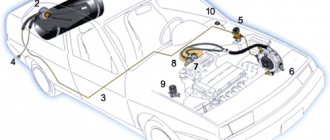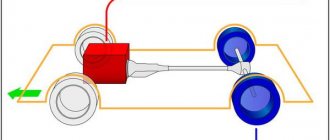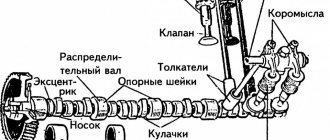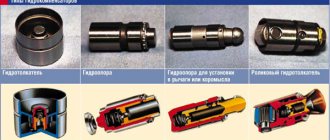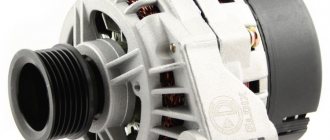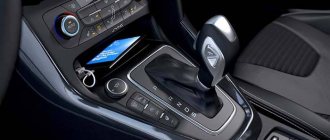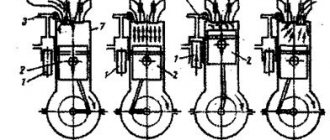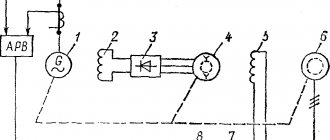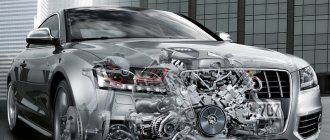What is an all-wheel drive transmission from Mitsubishi
The Super Select 4WD transmission was first implemented on the Pajero model. the required mode of movement at speeds of up to 90 km/h
- rear;
- four-wheel drive;
- all-wheel drive with locked center differential;
- reduction gear (at speeds up to 20 km/h). Super Select 4WD drive system
For the first time, the Super Select all-wheel drive transmission was tested on SUVs for the 24 Hours of Le Mans endurance sports competition. After high evaluations from experts, the system is installed as standard on all SUVs and minibuses of the company.
The design instantly switches mono-wheel drive to all-wheel drive mode on slippery surfaces. When driving off-road, the center differential locks.
Low gearing allows you to significantly increase torque at the wheels.
Summary
Strictly speaking, most cars marketed as all-wheel drive are not actually all-wheel drive. Today, the vast majority of cars sold that proudly wear the “4WD” nameplate are crossovers equipped with an electronically controlled all-wheel drive system. It’s good to drive such cars on asphalt in icy conditions or after a not very heavy snowfall - the electronics will help out by connecting all-wheel drive in a difficult situation. But it’s better not to venture into serious off-road conditions on such vehicles, since part-time with automatic connection is aimed primarily at improving handling, not cross-country ability.
If the vehicle's cross-country ability is of significant importance to you, but for some reason you cannot (or do not want) to purchase a car with a full-time 4wd transmission, then the best choice would be a part-time transmission that allows manual control of modes. Even better if it is a system like Super Select or Multi-Mode. The main thing you need to make sure of is that the transmission of the car you choose allows long-term movement in difficult conditions with all-wheel drive engaged.
Generations of the system on Pajero Sport and other models
Since production in 1992, the transmission has undergone only one modernization and one update. Generations I and II are distinguished by minor changes in the design of the differential and torque redistribution. The modernized Select 2+ system uses Thorsen, which replaces the viscous coupling.
Super Select 4WD drive system, 1st generation
The system consists of two main elements:
- transfer case with 3 modes;
- reduction gear or two-stage range.
Clutch synchronizers ensure mode switching directly while the car is moving.
A characteristic feature of the transmission is that the viscous coupling only corrects the operation of the differential when distributing torque. When driving around the city, the node is inactive.
The table below shows the use of Super Select transmission in Mitsubishi vehicles:
| Super Select first and second generation and 2+ | ||
| 1 | 2 | 2+ |
| Mitsubishi L200 Pajero (I and II) Pajero Sport Pajero Pinin Delica | Pajero (III and IV) Pajero Sport (III) | Mitsubishi L200 (V) Pajero Sport (III) |
Principle of operation
The first generation transmission uses a symmetrical bevel differential; the torque is transmitted through a sliding gear transmission with synchronizers. Gear changes are carried out using a lever.
Main characteristics of “Super Select-1”:
- mechanical lever;
- torque distribution between axes 50x50;
- reduction gear ratio: 1-1.9 (Hi-Low);
- use of 4N viscous coupling.
The second generation of the system received asymmetrical all-wheel drive, the torque transmission ratio changed - 33:67 (in favor of the rear axle), while the Hi-Low reduction ratio remained unchanged.
Super Select 4WD drive system, 2nd generation
The design replaced the mechanical control lever with an electronic one using an electric drive. By default, the transmission mode is set to 2H, with the rear axle driven. When all-wheel drive is connected, the viscous coupling is responsible for the correct operation of the differential.
In 2015, the transmission design was improved. The viscous coupling was replaced by a “Thorsen” differential, the system was called Super Select 4WD generation 2+. The system retained an asymmetrical differential, which transmits force in a ratio of 40:60, and the gear ratio 1-2.56 Hi-Low also changed.
To switch modes, the driver only needs to use the selector washer; there is no transfer lever.
Mitsubishi L200 ClubCab › Logbook › Installing the Super Select transfer case. FAQ.
I wanted to tackle this topic for a very long time, it was supposed to be full time by this winter, but the economic crisis associated with the presence of 2 SUVs delayed the moment.
Then an incident occurs and the car goes into a ravine due to the damned lightweight tailgate on the highway. searching for money for repairs, honestly I wouldn’t undertake the purchase in such a difficult time, but one okupant entertainer hinted that there is a full set of full-time, just buy more bolts for the cardan and go ahead. He waved his hand and took it. Based on the indicated weight, I realized that I couldn’t handle it in one person’s face. The father, with extensive work experience and properly sharpened hands, was called to help. Honestly, without him I would have died in this garage. He is the only one in the photo. Transfer case superselect Front cardan from superselect mechanics Rear cardan (sort of the same from mechanics) superselect 4 bolts securing the front cardan from superselect. they are different.
ATTENTION! Body 3cm SIGNIFICANTLY simplifies installation and dismantling of the entire structure
Disassembly: 1) First of all, we remove the protection. 2) Drain the oil from the box and transfer case 3) Unscrew the cardan shafts 4) We interrupt the crosspieces if they are missing and in this case we will need the rear cardan shank, which is included in the box, for which you will find out a little later 5) We begin to pull off the wiring from speed sensor and 2 transfer case position sensors. 6) We unscrew the transfer case, carefully look to see if we are turning the right bolts, I unscrewed 2 extra ones)) 7) The transfer case is glued very tightly, I removed it by jacking it up from below and it snapped off, the body is luminaire carefully with a hammer! 8) Next, the important point is to knock out the pin from the guide of the gearbox lever, the guide itself remains in the gearbox (as far as I remember, a long 160-200 mm bolt at 6 was used as a drift) 9) Next, we passed the cable under the transfer case and threw it to the floor after washing ourselves with the remaining oil in the crankcase))
Disassembly: 1) First of all, we remove the protection. 2) Drain the oil from the box and transfer case 3) Unscrew the cardan shafts 4) We interrupt the crosspieces if they are missing and in this case we will need the rear cardan shank, which is included in the box, for which you will find out a little later 5) We begin to pull off the wiring from speed sensor and 2 transfer case position sensors. 6) We unscrew the transfer case, carefully look to see if we are turning the right bolts, I unscrewed 2 extra ones)) 7) The transfer case is glued very tightly, I removed it by jacking it up from below and it snapped off, the body is luminaire carefully with a hammer! 8) Next, the important point is to knock out the pin from the guide of the gearbox lever, the guide itself remains in the gearbox (as far as I remember, a long 160-200 mm bolt at 6 was used as a drift) 9) Next, we passed the cable under the transfer case and threw it to the floor after washing ourselves with the remaining oil in the crankcase))
Assembly: 1) It is necessary to transfer the sensors indicating the position of the transfer case lever on the socket since on the superselect there is one wire coming out of the sensor, and on the easy one there are 2 pieces. mounting plates for the sensor plugs, since there might not be enough wiring and there is nothing to hook them to.4) Next, a very important point, insert the shank into the transfer case from behind, with the help of it we will get to the splines. in the box5) Clean off the standard sealant and apply a new one, like Elring or Reinz, a tube is enough. 6) We tie the transfer case with a cable through the gearbox hole, put the transfer case on our shoulder and begin to perform strange dances called hit the spline, while you can’t lower the transfer case too much since the gearbox guide is already inserted into the desired groove and can bend. At the same time, the person from the salon tries to coordinate your dance with reality. Rotation of the boaster can speed up the installation of the box by FOUR, or even TEN times, it took me about half an hour, the weight of the transfer case is 40-50 kilograms, fitness is not bad, I’ll tell you)) 7) Next, we tighten the bolts and nuts, I put them on the thread lock, when Since it was impossible to get to the nut, I used a long 14 socket, a universal joint + 2 extensions. 8) I assembled the universal joints and poured oil into the transfer case for flushing, and after a thousand km I will change it.
Super Select Features
The all-wheel drive system has four main and one additional operating modes, which allow the car to move on asphalt, dirt and snow:
- 2H - rear-wheel drive only. The most economical mode, used in the city on a regular road. In this mode, the center differential is completely unlocked.
- 4H - all-wheel drive with automatic locking. The transition to all-wheel drive can be done at speeds of up to 100 km/h from 2H mode by simply releasing the gas pedal and moving the lever or pressing the selector button. 4H provides maneuverability on any road while maintaining controllability. The differential will lock automatically when wheel slip is detected on the rear axle.
- 4НLc - four-wheel drive with rigid locking. The mode is intended for steep off-road conditions and for roads with minimal grip: mud, slippery slopes. 4НLc cannot be used in the city - the transmission is under critical load.
- 4LLc - active reduction gear. Used when it is necessary to provide the wheels with maximum torque. This mode must be activated only after the vehicle has come to a complete stop.
- R/D Lock is a special locking mode that allows you to simulate the locking of a cross-axle rear differential.
Advantages and disadvantages
The main advantage of the Mitsubishi transmission is the switchable differential all-wheel drive, which surpasses the well-known Part-Time in practicality. It is possible to change driving modes on the go. Using only rear-wheel drive reduces fuel consumption. According to the manufacturer, the difference in fuel consumption is about 2 liters per 100 km.
Additional benefits of the transmission:
- the ability to use all-wheel drive for an unlimited time;
- ease of use;
- versatility;
- reliability.
Despite the obvious advantages, the Japanese all-wheel drive system has a significant drawback - the high cost of repairs.
Differences from Easy Select
The Easy Select transmission is often called a lightweight version of the “Super Select”. The main feature is that the system uses a rigid connection of the front axle without a center differential. Therefore, all-wheel drive is engaged manually only when necessary.
Mitsubishi L200 (V) with Super Select 2+ transmission
Operating a vehicle equipped with the Easy Select system with all-wheel drive always engaged is prohibited. Transmission units are not designed for constant loads.
Easy Select
A simple and cheap option, which is usually referred to as “Part Time”. Something similar is found on UAZ cars. Key Features:
- the main thing is the rear axle, to which torque is constantly transmitted;
- the front axle is turned on/off by closing/opening a clutch installed on one of the drive shafts;
- There is no center differential, which is why there is no redistribution of torque between the axles.
The Easy Select all-wheel drive scheme used on the Mitsubishi L200 is reliable and efficient, but has two serious drawbacks. When connecting it, it is not allowed:
- long-term use on paved roads;
- driving at high speeds.
Violation of these rules causes failure of differentials and control clutches.
